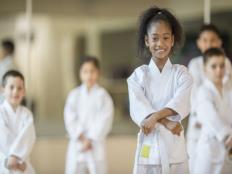On the top: starting a set on the 12 o'clock (or 60-second) mark on a poolside pace clock.
On the bottom: starting a set on the 6 o'clock (or 30-second) mark on a pace clock.
Tapering: the act of paring down your workouts (in length and intensity) for the weeks or days leading up to a specific race.
Full gear: all pulling equipment (buoy, tube, paddles) worn simultaneously during a pull set. The best way to get an upper-body swim workout.
Buoy: flotation device used to stabilize the legs and correct body position in the water.
Tube: a basic inner-tube from a small wheel used to bind your ankles while wearing a pull buoy; prevents kicking and helps keep legs together (and buoy from slipping).
Paddles: plastic hand-disks used to maximize an upper-body pulling workout. Available in several shapes and sizes, depending on your skill and preference.
Dragsuit: a baggy, nylon unisex swimsuit, worn over a regular practice suit to add resistance to everyday training.
Band training: dry-land workout using rubber stretch cords to strengthen muscles used in all four strokes.
Hypoxic training: any type of set where a breathing pattern is the focal point of the drill.
More: 3 Workouts to Improve Your Swim
3:1: Breathing pattern where you take one breath for every three strokes; this is a bilateral breathing pattern (you breathe on both left and right sides).
2:1: Breathing pattern where you breathe once for every two strokes (you only breathe on one side, your left or right).
Circle swimming: swimming in a lane in a standard counter-clockwise direction, up the right side and back down the left. Preferable when more than one person is sharing your lane.
Catch-up stroke: special drill where basic crawl (freestyle) is altered so that each arm catches up with the other before completing the next stroke (one arm is stationary above your head, in beginning-stroke position, while the other completes a full stroke rotation).
Sculling: special drill using only your hands (not your arms) to scull your way through the water; arms at your sides, with your wrists whipping back and forth in a waving motion (designed to develop feel for the water). Good workout when lap swimming is not an option (hotel pools, crowded slow lanes).
Vertical kicking: special drill executed in deep water (diving wells and deep ends of hotel pools when lap swimming is not an option) where one kicks in a vertical position with arms crossed over chest, or extended above head for various intervals/sets.
 Find kids swimming lessons & classes near you.
Find kids swimming lessons & classes near you.
A former swimmer at Stanford University, Alex Kostich has stayed strong in the sport at the elite level even while maintaining a day job. The three-time Pan-American Games gold medalist still competes in—and wins—numerous open-water races around the world each year, as well as competing in the occasional triathlon and running race.
Related Articles:
? 9 Good Reasons Why You Should Get in the Pool
- 2
- of
- 2









Discuss This Article